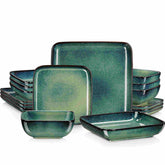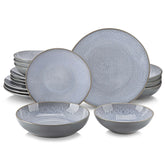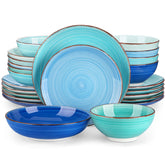Butter Dish vs. Butter Crock: Finding the Ideal Way to Store Your Butter
- Butter Dish: How it Works?
- The Butter Crock (Butter Bell / French Butter Keeper)
- Key Differences between Butter Dish vs. Butter Crock
- Choosing between Butter Dish and Butter Crock
- Material and Design Options for Butter Dishes and Butter Crocks
If you cook or bake regularly, you know the frustration of trying to spread hard, cold butter on toast or finding your butter has gone rancid on the counter. Most kitchens use either a butter dish or a butter crock, but which one actually works better? Both options keep butter fresh and ready to use, but they work in completely different ways. This guide compares butter dishes and crocks to help you choose the one that best fits your cooking habits, maintenance preferences, and kitchen style.
Butter Dish: How it Works?
The simple but classic way to store butter is in a butter dish. A shallow tray or plate with a cover to keep the butter from contaminants and air exposure is usually what it is. Glass, ceramic, porcelain, plastic, or stainless steel can be used to make butter dishes. Some have a lid-type airtight seal, and some have a more conventional open design.
How it Works
Butter is placed directly on the base of the dish. The lid protects it from dust, odors, and bacteria. It's usually kept on the kitchen counter or in the refrigerator, depending on personal preference. At room temperature, it is easier to spread, and refrigeration extends freshness.
Advantages of a Butter Dish
- Simple and elegant design.
- It makes butter easy to use and readily available.
- Available in various materials and styles to match any kitchen decor.
- Requires minimal maintenance.
Drawbacks of a Butter Dish
- If butter is stored in the refrigerator, it may become too hard.
- Exposure to air can cause oxidation over time and affect flavor.
- Butter can spoil or become too soft if left at room temperature for too long.
The Butter Crock (Butter Bell / French Butter Keeper)
A butter crock, also called a butter bell or French butter keeper, is a more sophisticated method of storing butter so that it stays fresh and spreadable without refrigeration. The two main components of it are an outer base that holds water and an inner lid that contains the butter.
How it Works
It is butter packed into the lid or bell-shaped container. Then a small amount of water is poured into the base, making it airtight. The water acts as a barrier against air, keeping the butter fresh when inverted. The butter remains at the perfect spreading consistency at room temperature.
Advantages of a Butter Crock
- Keeps butter soft and spreadable.
- It prevents oxidation and absorption of unwanted odors.
- It keeps butter fresh for weeks without refrigeration.
- It helps to reduce the risk of spoilage from air exposure.
Drawbacks of a Butter Crock
- It needs regular water changes to prevent bacteria growth.
- Using it can be messier than using a butter dish.
- It has a limited butter storage capacity.
Key Differences between Butter Dish vs. Butter Crock
Storage Method
The primary difference between the two lies in their storage methods. A butter dish is an open air container with a cover, while a butter crock is an airtight water seal to keep butter fresh. This is a big difference that affects the butter’s texture, freshness, and maintenance requirements.
Spreadability
Storing butter is one of the biggest concerns when it comes to spreadability. Maintaining room temperature is crucial for a butter dish, as butter can become too firm in cooler areas or too soft in warmer ones. A butter crock, on the other hand, is made to keep the butter soft and spreadable at all times. A butter crock has a water seal to regulate temperature and moisture, keeping the butter at the right consistency.
Freshness and Longevity
The two storage options also differ greatly in freshness and longevity. Butter dishes tend to expose butter to air over time, which can cause oxidation and degrade the taste and quality of the butter. However, butter spoils when it is exposed to air and bacteria, but that water sealed environment of a butter crock keeps the butter away from the air and bacteria, which adds to the freshness, reduces spoilage, and keeps butter fresher longer. The butter crock is a preferred choice if you want to keep butter fresh without refrigeration.
Maintenance
Maintenance is another factor to consider when deciding between a butter dish and a butter crock. A butter dish is low maintenance and only needs to be cleaned occasionally. However, a butter crock is more maintenance: It needs more frequent water changes to prevent bacterial growth and keep the airtight seal.
Capacity
The other important difference between these storage methods is capacity. A standard butter dish can accommodate an entire stick (or more) because households that rely heavily on butter should have one. Half a stick fits in a butter crock, and refilling a butter crock is not as frequent as a butter crock. The capacity difference may also influence which option is more suitable for a household’s butter consumption habits.
Choosing between a butter dish and a butter crock depends on your daily needs. Butter dishes are simpler to use and need less maintenance, making them perfect for busy households. Butter crocks keep your butter fresher longer and maintain a spreadable consistency, which is ideal if you enjoy butter that's always ready to use.

Choosing between Butter Dish and Butter Crock
Choose Butter Dish
If you prefer a simple, traditional storage method, choose a Butter Dish. Butter dish is a better option if:
- You use refrigerated butter often.
- You want a storage solution that is low maintenance.
- Butter requires a larger storage capacity.
Choose Butter Crock
If you prefer soft, spreadable butter at all times, choose a Butter Crock. It is a better option if:
- You don’t want butter to oxidize and absorb fridge odors.
- You don’t mind the maintenance of changing water every few days.
- You only use small amounts of butter at a time and refill as needed.
Material and Design Options for Butter Dishes and Butter Crocks
Butter dishes and butter crocks are available in a variety of materials and styles to match your kitchen’s aesthetic.
Butter Dish Material Choices
Glass: Transparent, classic, and easy to clean.
Ceramic/Porcelain: Elegant and heat-resistant, but fragile.
Plastic: Lightweight and durable, but may absorb odors over time.
Stainless Steel: Modern and durable, but not always transparent for visibility.
Butter Crock Material Choices
Ceramic/Porcelain: Traditional and excellent at maintaining cool temperatures.
Stoneware: Retains temperature well, keeping butter fresh longer.
Glass: Less common but allows visibility of butter.
Design Considerations
Choose a style that matches your kitchen decor.
Lid Type: Airtight lids help keep butter fresher longer.
Size & Capacity: Consider how much butter you use regularly.
There are butter dishes and butter crocks and they all have their own pros and cons of which one fits your cooking and kitchen best. If you tend to refrigerate butter or use it in larger quantities, a butter dish is a simple and elegant choice. However, a butter crock is a better way to keep soft, fresh butter without refrigeration, but it requires more work.
In the end it all comes down to convenience, maintenance, and how you prefer your butter — firm and cool, or soft and spreadable. But whatever you do, either will make the butter experience better and make every slice of toast or buttered dish a treat.












